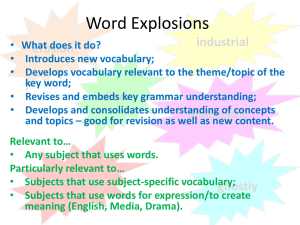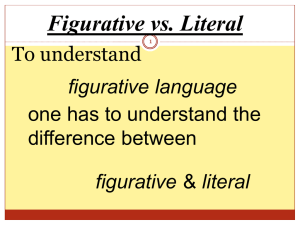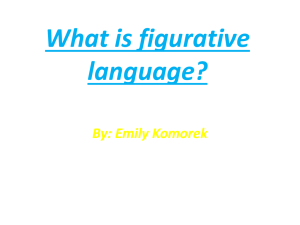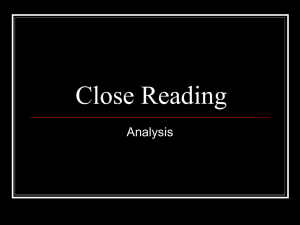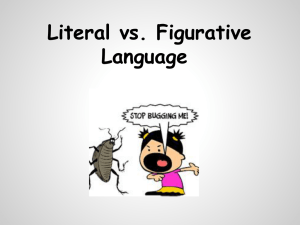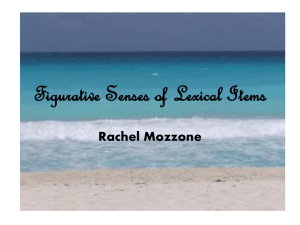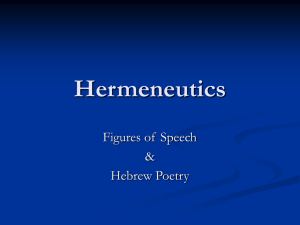Figurative Language Powerpoint
advertisement
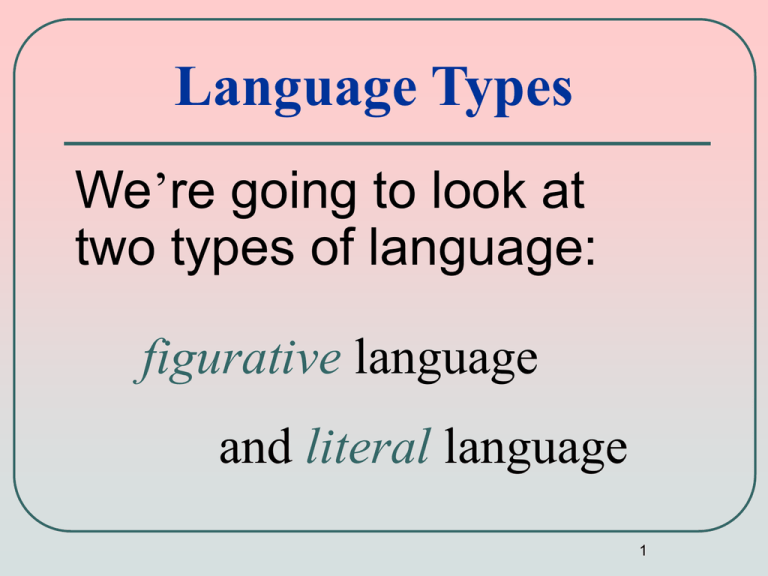
Language Types We’re going to look at two types of language: figurative language and literal language 1 Figurative vs. Literal To understand what figurative language is,one needs to understand the difference between figurative and literal 2 LET’S START WITH LITERAL To be literal is to state what you mean or mean what you say. For example: If I tell you to, “Stop whining!” I mean it literally, “Stop whining.” as in “Stop whining and put a smile on your face, please.” I am directly stating what I mean. 3 Here’s another example: I’m tired and going home. This means “I’m tired and I’m going home.” There is no other meaning other than what is said. I mean exactly what I stated. 4 FIGURATIVE To be figurative is to not mean what you say but to imply something else. For example: If I tell you, “Let’s go chill,” I’m not suggesting we get into the freezer. 5 “Let’s go chill.” … means let’s relax together and do something fun. It has nothing to do with temperature. 6 Literal vs. Figurative Confused? Think of it this way: Literal is stated directly Figurative is imaginary 7 Why Use Figurative Language? Also known as descriptive language, or poetic language, figurative language helps the writer paint a picture in the reader’s mind. 8 Figurative Language makes reading more interesting. 9 LET’S PRACTICE! Brian was a wall, bouncing every tennis ball back over the net. This figurative phrase compares Brian to a wall because __________. a. He was a strong tennis player. b. He was very tall. c. He kept missing the balls. d. His body was made of cells. 10 We would have had more pizza to eat if Tammy hadn’t been such a hog. Tammy was being compared to a hog because she __________. a. looked like a hog b. ate like a hog c. smelled like a hog d. was as smart as a hog 11 Cindy was such a mule. We couldn’t get her to change her mind. This figurative phrase compares Cindy to a mule because she was __________. a. always eating oats b. able to do hard work c. raised on a farm d. very stubborn 12 The poor rat didn’t have a chance. Our old cat, a bolt of lightning, caught his prey. The cat was compared to a bolt of lightning because he was _______. a. very fast b. very bright c. not fond of fleas d. very old 13 The leaves danced in the wind. Do leaves really dance? Of course not! Close your eyes and picture leaves “dancing in the wind.” What do you see? Why do you think an author would choose to use “dancing” to show what the leaves were doing? 14 He never listens to his mom.” Never? That is a very long time. His mom might want to have his hearing checked. Never is an exaggeration. It is figurative language, not literal. 15 We have a ton of homework. Oh really? A ton is a thousand pounds. You would need to have big muscles and a HUGE backpack! This is figurative language. 16 LET’S REVIEW Literal vs. Figurative Remember: Real vs. Imaginary 17


